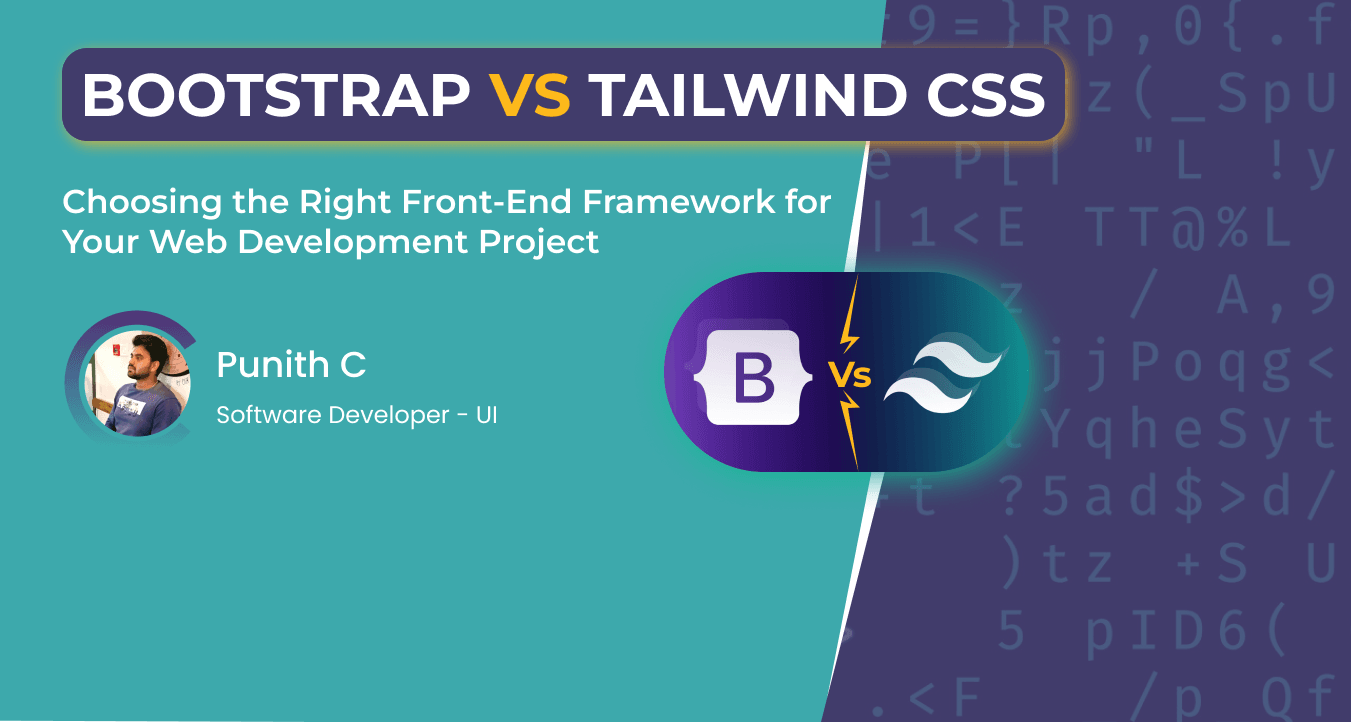Bootstrap and Tailwind CSS are two popular front end frameworks used by web developers to create modern and responsive websites. There are some significant variations between the two frameworks, even though they both have many features and advantages. To help you choose which one to use for your next web development job, we'll compare Bootstrap and Tailwind CSS in this blog post.
Bootstrap
Twitter created Bootstrap, a well-known front-end platforms. It's intended to make it quick and simple for developers to build websites that are mobile-friendly and responsive. Bootstrap is renowned for its large collection of pre-made elements, which includes buttons, forms, and navigation panels. With JavaScript plugins, Bootstrap offers more functionality, and these elements are readily customizable using CSS.
Advantages of Bootstrap
1. Pre-built Components: The vast collection of pre-built components in Bootstrap can save developers a good amount of time and effort. Pre-built components can be easily integrated into your website and modified as required, so you don't have to start from scratch.
2. Responsive Design: Bootstrap is built with mobile devices in mind, so webpages made with it are responsive and mobile-friendly. This makes sure that your website works and appears great across all platforms, including desktops and mobile devices.
3. Consistency: Bootstrap gives your complete website a unified design language. This makes it easier to guarantee that your website has a polished, consistent design language and company identity.
4. Community Support: Bootstrap is a popular framework with a large community of developers, which means that you can find plenty of resources and support online. User communities, manuals, and tutorials are all examples of this.
Tailwind CSS
A more modern front-end framework that has grown in popularity is called Tailwind CSS. It differs from Bootstrap in that it offers a collection of utility classes that you can use to design your website. Since these programs are intended to be combined, you can do so in a variety of ways to produce distinctive and personalised styles.
Advantages of Tailwind CSS
1. Customization: Tailwind CSS allows you to build a wide range of custom styles using the utility classes. This gives you the freedom to design a website however you like without being constrained by pre-made elements.
2. Lightweight: A small amount of code and dependencies are not needed when using the Tailwind CSS system. As fewer files need to be downloaded and processed, your website will open quicker and perform better as a result.
3. Consistency: Tailwind CSS offers a uniform design language throughout your complete website, much like Bootstrap does. As opposed to using pre-built components, the strategy is distinct because utility classes are used.
4. Accessibility: The accessibility of all users, including those with disabilities, is taken into consideration in the creation of Tailwind CSS, so you can build websites that are accessible to all users.
Bootstrap vs Tailwind CSS: Which one to choose?
- Both Bootstrap and Tailwind CSS are potent front-end frameworks that can assist you in quickly and simply building responsive and mobile-first websites. When choosing which one to use, there are a few significant differences to take into consideration.
- Bootstrap may be a better option for you if you're searching for a framework with a sizable library of pre-built components. Bootstrap is well-known and widely used, so you can discover a ton of information and support online.
- However, Tailwind CSS might be a superior option if you want more freedom in terms of customizing and designing your website. Without being restricted by pre-built components, Tailwind CSS allows you to build distinctive and personalized styles using utility classes.
- Additionally, Tailwind CSS might be a superior option if you want a compact framework that puts an emphasis on performance and accessibility. Tailwind CSS focuses on accessibility and modification while being lightweight and effective.
- Finally, it can be said that both Bootstrap and Tailwind CSS are excellent front-end frameworks that provide various methods for web creation. Your particular requirements and preferences as a developer will eventually determine your decision.
- Bootstrap has a simpler and more well-established structure than other frameworks, making it a good option if you're just getting started with web programming. You can get started quickly and easily while still allowing for customization with Bootstrap's large collection of pre-built components.
- However, Tailwind CSS may be a better choice if you have more web development experience and desire a more individualized strategy. Because Tailwind CSS places a strong emphasis on customization, its utility classes give you more freedom and control while enabling you to make one-of-a-kind designs that are catered to your particular requirements.
- The learning rates for each framework vary as well. It can take some time to become proficient in using Bootstrap despite the fact that there is a sizable developer community and a wealth of online tools. Comparably, the utility classes in Tailwind CSS can be challenging at first, but once you grasp how they operate, they can be extremely useful and effective.
- In the end, each of the two frameworks—Bootstrap and Tailwind CSS—offers special advantages and benefits. The decision between the two will be based on your individual demands as a developer and the specifications of the project you're working on.
Conclusion
In conclusion, you can create modern, responsive websites with the help of two strong front-end systems: Bootstrap and Tailwind CSS. While Tailwind CSS offers more customization and control due to its utility classes, Bootstrap is known for its sizable collection of pre-built components. Think about the amount of web development expertise, your unique needs, preferences, and the specifications of your project when choosing between the two frameworks. In the end, both Bootstrap and Tailwind CSS have special benefits of their own and can be useful tools for web developers. Contact Appiness Interactive, the finest website design company in Bangalore, which incorporates UI development psychology when modifying or creating any websites, to find the ideal balance.




